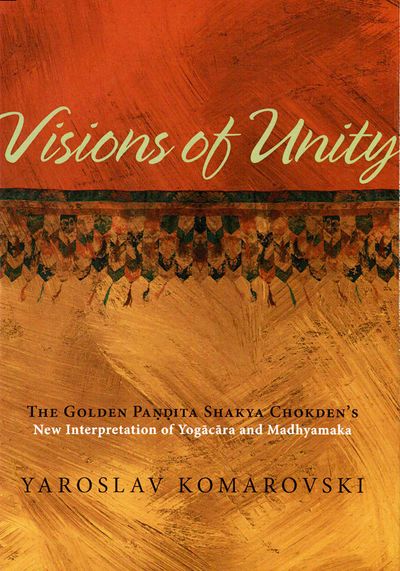Yaroslav Komarovski's Visions of Unity is a thick study of Śākya Chokden, a fifteenth-century Sakya philosopher who wrote extensively on Yogācāra and Madhyamaka in an attempt to synthesize the two. He wrote at a time that a strict interpretation of Madhyamaka was in ascendence and Yogācāra was dismissed as a lesser teaching. Śākya Chokden was a passionate critic of Tsongkhapa, and stridently faulted the Geluk patriarch for spreading nihilism to his own beloved Sakya tradition. He was himself a follower of Madhyamaka, but he embraced many elements of Yogācāra; his attempt at a synthesis was to reclassify the different strands of Yogācāra and Madhyamaka so as to combine those that he liked and dispense with those he did not. Although his writings were recognized for their brilliance, his criticisms of Tsongkhapa and Sakya Paṇḍita, and his qualified acceptance of "other-emptiness" (gzhan stong) meant that he was almost entirely rejected by his peers.
Śākya Chokden was an accomplished scholar and practitioner of tantra, and his eagerness to preserve elements of Yogācāra arose from his desire to provide an intellectual basis by which to merge sūtra and tantra. Komarovski skillfully places Śākya Chokden in a long history of Yogācāra-Madhyamaka syntheses, a tradition that Śākya Chokden accused Tsongkhapa of abandoning in his radical interpretation of Candrakīrti and rejection of all positive-language doctrine.
Tibetan philosophers frequently turned to doxography to advocate their own interpretation of Buddhist doctrine. Since no teaching of the Buddha could be discarded, all had to be organized in a soteriological hierarchy; that is, the teachings that best bring a practitioner to a realization of the ultimate are better than those teachings that were offered to soothe fears or inspire action. For Geluk thinkers who Śākya Chokden opposed, for example, the teachings of buddha-nature were not to be taken literally. In his effort to merge the positive- and negative-language teachings of Yogācāra and Madhyamaka, Śākya Chokden developed a unique doxography that redefined both. In dense but readable prose Komarovski explains how Śākya Chokden reclassified elements of each (the Satyākāravāda doctrine of the Yogācāra, and the Prasaṅgika branch of the Madhyamaka) as true Madhyamaka; each was capable of bringing people to a realization of the ultimate, one with positive language and the other with negative.


